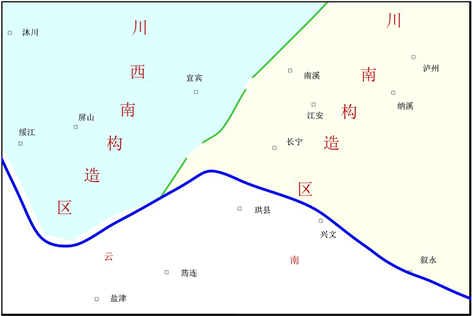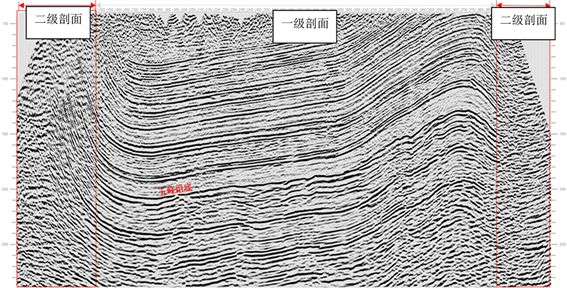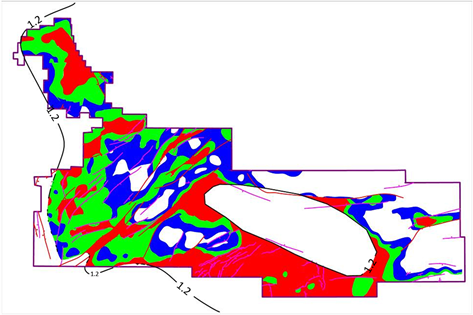Advances in Geosciences
Vol.
09
No.
03
(
2019
), Article ID:
29427
,
7
pages
10.12677/AG.2019.93019
Favorable Blocks Optimization of Shale Gas Based on 2D Seismic Surveys in SN, Sichuan Basin
Bo Jiang, Zenghui Fan, Xiao Yang, Xiaojiang Deng, Xiaolan Wang, Cheng Huang, Lijuan Huang, Shiyu Zhou, Ruining Li, Dengbi Ding
Southwest Geophysical Research Institute, CNPC Bureau of Geophysical Prospecting INC, Chengdu Sichuan

Received: Mar. 6th, 2019; accepted: Mar. 19th, 2019; published: Mar. 26th, 2019

ABSTRACT
The Silurian Longmaxi Formation in the Sichuan Basin is rich in shale gas resources and has good geological conditions. It is especially important to find favorable shale gas blocks that can be of commercial development value based on geological results. Two-dimensional seismic data in the Sichuan Basin is abundant, which can be used to deliver 2D seismic data quality evaluation results, 2D seismic reflection structural results, 2D seismic reflection buried depth results, 2D seismic fault classification evaluation results, and 2D seismic high-quality reservoir prediction results. The reservoir evaluation and the favorable area selection have been done based on the results above. The favorable areas of the 2D seismic shale gas exploration should have good seismic data quality and small formation dip angles (less than 30 degrees). They should be away from the faults (more than 1.5 km from the first-class faults and more than 0.7 km from the second-class faults) and the denudation line (greater than 8 km), with moderate buried depth (1500~4500 m) and shale formation thickness (more than 20 m). The effective commercial development of shale gas is employed in the favorable areas. The research shows that the JW syncline, LC syncline and SL syncline of the CN block in the SN area have better exploration and development potential. Currently, the JW syncline block, which is a national shale gas demonstration block now, has entered the stage of the field development.
Keywords:Favorable Blocks Optimization, Shale Gas, SN Area, Sichuan Basin
四川盆地SN地区二维地震勘探 页岩气有利区带优选
蒋波,范增辉,杨晓,邓小江,王小兰,黄诚,黄丽鹃,周诗雨,李睿宁,丁登碧
中国石油东方地球物理公司西南物探研究院,四川 成都

收稿日期:2019年3月6日;录用日期:2019年3月19日;发布日期:2019年3月26日

摘 要
四川盆地志留系龙马溪组页岩气资源较为丰富,地质条件较好,如何在利用地质成果进行选区的基础上,准确找到可以具有商业开发价值的页岩气区块尤为重要。四川盆地二维地震资料丰富,利用二维地震资料编制二维地震资料品质评价成果、二维地震反射构造成果、二维地震反射埋深成果、二维地震断层分级评价成果以及二维地震优质页岩预测成果。通过地震资料所得各项成果的分析,要求地震资料品质较好、地层倾角较平缓(地层倾角小于30度)、离断层分级评价成果中的各级断层有一定的距离(离一级断层大于1.5 km,离二级断层大于0.7 km)、离剥蚀线的距离较远(大于8 km)、优质页岩的埋深情况适中(1500~4500 m)以及优质页岩的厚度较厚(大于20 m),进行有利区域的优选,实现页岩气的二维地震勘探有利区域的优选工作。再在二维地震勘探页岩气有利区带优选的有利区内实现页岩气的有效的商业开发,研究表明SN地区CN区块的JW向斜、LC向斜、SL向斜等具有较好的勘探开发潜力,目前JW向斜区块页岩气的开发进入实质性开发阶段,已成为国家级页岩气示范区。
关键词 :区带优选,页岩气,SN地区,四川盆地

Copyright © 2019 by author(s) and Hans Publishers Inc.
This work is licensed under the Creative Commons Attribution International License (CC BY).
http://creativecommons.org/licenses/by/4.0/


1. 前言
随着水平井及分段压裂技术的突破,北美地区页岩气发展迅速,页岩气资源的战略地位逐渐为人们所重视 [1] [2] [3] [4] [5] 。中国页岩气具有良好的发展前景,资源量约为陆上常规天然气资源的2倍。2010年,四川盆地威远地区志留系页岩获得商业性气流,实现中国页岩气首次工业性突破,证实了南方地区志留系龙马溪组页岩是最有利勘探层系之一。国内外主要通过获取待选区域的区域地质背景,划分待选区域的区域地质背景分类,采取待选区域的目的层岩样进行烃源岩特征分析,根据待选区域的页岩气保存条件静态指标,根据在待选区域内钻取的预探井的沉积埋藏史和生排烃史获得待选区域的页岩气保存条件动态指标,进行页岩气的选区。本文以四川盆地SN地区为重点,在地质优选有利区的基础上利用二维地震资料对志留系龙马溪组页岩气的有利条件进行进一步优选,以期为页岩气勘探开发提供有益的参考。
2. 概况
研究区处于川西南古中斜坡低褶带和川南娄山褶皱带之间(图1),主要发育长宁构造、天宫堂构造、鹰草湾构造。
研究区龙马溪组为深水陆棚沉积,具备良好的物质基础,页岩TOC含量4%~4.5%,平均4.3%;有效页岩厚21~26 m,平均24 m,主要位于龙马溪组下部;有机质为腐泥型,热演化程度高(3.2% > Ro > 3.1%),

Figure 1. Sketch map of the study area
图1. 研究区构造位置简图
处于高-过成熟度阶段;页岩纳米级孔隙发育,具有较好的储集条件,孔隙度5.5%~5.7%,平均5.6%;脆性矿物含量高,石英含量30%~60%,平均45%;页岩含气量较高5~7.5 m3/t,平均6 m3/t;地层压力系数较高,在1.2~2,平均1.6。
通过N201井、N203、N209等多口井在龙马溪组页岩气压裂后获得工业天然气流并稳产,证实该区具有良好的勘探前景。
3. SN地区龙马溪组页岩气二维地震成果情况
3.1. 二维地震资料品质
研究区出露奥陶系–白垩系地层,岩性包括灰岩、长石石英砂岩、砂泥岩互层等,出露岩性横向变化大。所获得的地震资料总体成像清楚,褶曲特征清楚,断面清晰,能合理可靠地刻画地腹地质现象。根据页岩气地震资料评价标准,将信噪比高、同相轴连续、波组特征清楚,评为一级剖面;将信噪比低、同相轴不连续、波组特征不清楚,评为二级剖面(图2);经过评价,一级剖面占82.2%,二级剖面占17.8% (图3)。

Figure 2. The Quality profile of Seismic data
图2. 地震资料品质剖面图

Figure 3. The map of Seismic data quality in the study area
图3. 研究区地震资料品质平面图
3.2. 二维地震埋深情况
页岩埋深是评价页岩气是否具有经济开采能力的重要指标,优质页岩埋深小于1500 m,通常地层压力不够,离剥蚀面太近,产量太低,不具备工业开采价值,优质页岩埋深大于4500 m,受压裂工艺的限制,不能进行正常的开发。研究区上奥五峰组底埋深适中,主要集中在1500~6000 m变化(图4)。研究区大部分区域埋深集中在1500~4500 m。1500~2000 m面积为247.84 km2;2000~2500 m面积为435.00 km2;2500~3000 m面积为472.27 km2;3000~3500 m面积为926.76 km2;3500~4000 m面积为1673.53 km2;4000~4500 m面积为1394.66 km2。总体研究区1500~4500 m内的面积较大,有利于页岩气的勘探开发。

Figure 4. The Seismic reflection depth map of the bottom boundary of the Upper Wufeng Formation in the study area
图4. 研究区上奥五峰组底界地震反射埋深图
3.3. 二维地震断层分类评价情况
页岩气勘探开发受断层断开层系和断距的大小影响,离断层近,则保存条件可能将受到破坏,同时水平井钻井过断层将影响优质页岩钻遇率 [6] ,同时影响开发产量,根据实际生产经验,将断层分为四类(图5),I类断层(控制断层,向上断开须家河组底界):20条;II类断层(向上断开上二叠底):70条;III类断层(向上未断穿上二叠底、断距大于40米):80条;IV类断层(向上未断穿上二叠底、断距小于40米):225条。I类断层、II类断层直接影响页岩气的保存条件,III类断层会影响勘探开发钻井时水平井的钻井,IV类断层钻井时可以采取钻井工艺进行避让。

Figure 5. The Classification evaluation diagram of the bottom boundary fault of the Upper Wufeng Formation in the study area
图5. 研究区上奥五峰组底界断层分类评价图
4. 页岩气勘探有利区优选
根据国内外页岩气勘探开发成功经验,结合四川盆地实际的地质情况,页岩气在很大程度上受控于页岩的有机碳、成熟度、脆性矿物、孔隙度、含气量、优质页岩厚度、压力系数、埋藏深度、断裂分布以及离剥蚀面的距离等因数 [7] - [12] 。首先在四川盆地根据地质评价标准(表1),选择了研究区为地质评价有利区。
Table 1. The standard of Geological evaluation
表1. 地质评价标准
再利用二维地震成果预测页岩埋深,断裂情况进行综合的有利区域优选(表2)。
Table 2. The standard of Seismic evaluation
表2. 地震评价标准
通过综合评价,研究区志留系龙马溪组~五峰组有利区带评价成果(图6),I类有利区主要集中在研究区东南和西北相对高部位,面积为

Figure 6. Evaluation map of the favorable area of the Longmaxi Formation-Wufeng Formation of the Silurian system in the study area
图6. 研究区志留系龙马溪组–五峰组有利区带评价图
5. 结论
利用二维地震资料编制二维地震资料品质评价成果、二维地震反射构造成果、二维地震反射埋深成果、二维地震断层分级评价成果以及二维地震优质页岩预测成果,进行有利区域的优选,实现页岩气的二维地震勘探有利区域的优选工作。通过该评价方法优选的有利区,目前这些区块已成为国家级页岩气示范区,说明这些有利区优选方法适用、可靠,为页岩气勘探开发做出了巨大贡献。
文章引用
蒋 波,范增辉,杨 晓,邓小江,王小兰,黄 诚,黄丽鹃,周诗雨,李睿宁,丁登碧. 四川盆地SN地区二维地震勘探页岩气有利区带优选
Favorable Blocks Optimization of Shale Gas Based on 2D Seismic Surveys in SN, Sichuan Basin[J]. 地球科学前沿, 2019, 09(03): 159-165. https://doi.org/10.12677/AG.2019.93019
参考文献
- 1. Loucks, R.G., Reed, R.M., Ruppel, S.C., et al. (2009) Morphology, Genesis, and Distribution of Nanometer-Scale Pores in Siliceous Mudstones of the Mississippian Barnett Shale. Journal of Sedimentary Research, 79, 848-861. https://doi.org/10.2110/jsr.2009.092
- 2. Wang, F.P., Reed, R.M., John, A., et al. (2009) Pore Networks and Fluid Flow in Gas Shale. SPE Annual Technical Conference and Exhibition, New Orleans, LA, 4-7 October 2009, SPE-124253-MS.
- 3. Sondergeld, C.H., Ambrose, R.J., Rai, C.S., et al. (2010) Micro-Structural Studies of Gas Shales. SPE Unconventional Gas Conference, Pittsburgh, PA, 23-25 February, SPE-131771-MS.
- 4. Hill, R.J., Zhang, E., Katz, B.J., et al. (2007) Modeling of Gas Generation from the Barnett Shale, Fort Worth Basin, Texas. AAPG Bulletin, 91, 501-521. https://doi.org/10.1306/12060606063
- 5. Loucks, R.G. and Ruppel, S.C. (2007) Mississippian Barnett Shale: Lithofacies and Depositional Setting of a Deep-Water Shale-Gas Succession in the Fort Worth Basin, Texas. AAPG Bulletin, 91, 579-601. https://doi.org/10.1306/11020606059
- 6. 黄金亮, 邹才能, 李建忠, 等. 川南志留系龙马溪组页岩气形成条件与有利区分析[J]. 煤炭学报, 2012, 37(5): 782-787.
- 7. Yan, C., Huang, Y., Ge, C., et al. (2009) Shale Gas: Enormous Potential of Unconventional Natural Gas Resources. Natural Gas Industry, 29, 1-6.
- 8. Zou, C., Dong, D., Wang, S., et al. (2010) Geological Characteristics and Resource Potential of Shale Gas in China. Petroleum Exploration and Development, 37, 641-653. https://doi.org/10.1016/S1876-3804(11)60001-3
- 9. Wan, F. and Xu, X. (2003) Tectonic-Lithofacies Palaeogeography of the Silurian in Sichuan-Yunnan-Guizhou-Guangxi Region. Journal of Palaeogeography, 5, 180-186.
- 10. Curtis, J.B. (2002) Fractured Shale-Gas Systems. AAPG Bulletin, 86, 1921-1938.
- 11. Boyer, C., Kieschnick, J., Lewis, R.E. and Waters, G. (2006) Producing Gas from Its Source. Oilfield Review, 18, 36-49.
- 12. Sondergeld, C.H., Newsham, K.E., Comisky, J.T., et al. (2010) Petrophysical Considerations in Evaluating and Producing Shale Gas Resources. SPE Unconventional Gas Conference, Pittsburgh, PA, 23-25 February, SPE-131768-MS.
